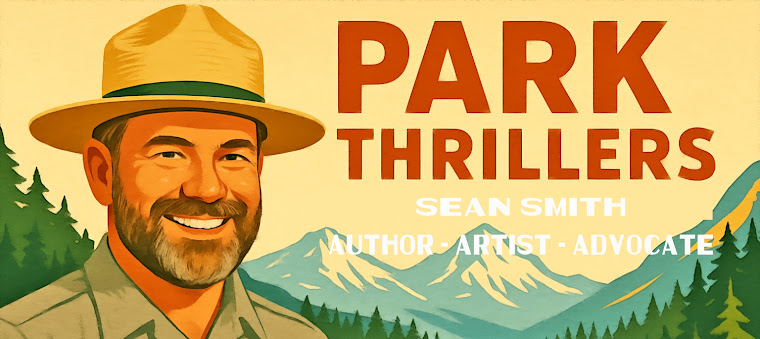 |
| Yellowstone's Biscuit Basin ~ NPS |
Yellowstone’s Biscuit Basin: The Power of Geothermal Activity
Yellowstone National Park, home to one of the world’s most active geothermal systems, recently witnessed a significant thermal explosion in the Biscuit Basin. This event is a powerful reminder of the volatile forces at work beneath the park’s surface. The explosion, caused by superheated water rapidly converting to steam, is part of a broader pattern of geothermal activity that has shaped Yellowstone for millennia.
For the NPS, managing a place like Yellowstone means acknowledging and respecting these natural processes. Instead of attempting to prevent or mitigate such events, the NPS allows them to occur naturally, understanding that they are essential to the park's identity. This approach underscores the importance of protecting the processes that continue to shape the landscape rather than trying to maintain a static, unchanging facade.
Glen Canyon’s Double Arch Collapse: The Impermanence of Geological Formations
In Glen Canyon National Recreation Area, the collapse of the Double Arch is another example of the ever-changing nature of national parks. Arches and other rock formations result from millions of years of erosion, and their eventual collapse is a natural part of that process. While these features are beloved by visitors, their impermanence is a fundamental aspect of their existence.
Historically, there might have been attempts to stabilize or preserve such formations to maintain the park’s aesthetic appeal. However, the NPS has shifted its approach, recognizing that these natural changes are integral to the landscape's story. By allowing natural erosion and other processes to continue unabated, the NPS ensures that visitors can witness the entire cycle of these formations, deepening their understanding and appreciation of the natural world.
North Cascades’ Pioneer Fire: The Role of Fire in Ecosystem Health
Wildfires, like the Pioneer Fire currently burning in North Cascades National Park, are often perceived as destructive forces. However, fire is a natural and necessary part of many ecosystems, including those in the North Cascades. Fire helps to clear out dead wood, promote new growth, and maintain the overall health of the forest.
The NPS has increasingly embraced the role of fire in maintaining healthy ecosystems. Instead of suppressing all fires, the NPS now manages them with an understanding of their ecological importance. This shift reflects a broader recognition that fire, while sometimes destructive, is also a natural process that plays a crucial role in shaping the landscape. By allowing fires to burn under controlled conditions, the NPS helps ensure these ecosystems remain vibrant and resilient.
The National Park Service’s Evolving Mission
The NPS's mission to preserve parks "unimpaired" has evolved significantly over the years. In the early days, this often meant trying to freeze parks in a state of perpetual beauty, preventing any changes that might alter their appearance. However, this approach conflicted with the natural processes that are essential to the health and integrity of these landscapes.
Today, the NPS’s management philosophy has shifted to one that prioritizes the protection of natural processes. This approach acknowledges that change is an inherent part of nature and that attempting to lock landscapes in a frozen state would ultimately do more harm than good. By focusing on preserving the processes that shape these environments, the NPS ensures that parks can continue to evolve and thrive, providing visitors with a more authentic and meaningful experience.
Why It’s Important to Protect Natural Processes
Protecting natural processes, rather than trying to maintain a static landscape, is crucial for several reasons:
Ecological Health: Natural processes like erosion, fire, and geothermal activity are essential to ecosystem health. They promote biodiversity, renew landscapes, and maintain the balance of nature. Without these processes, ecosystems can become stagnant and less resilient to changes such as climate change.
Authentic Visitor Experiences: By allowing natural processes to unfold, the NPS provides visitors with an authentic experience of the natural world. Witnessing the dynamic changes in the landscape can deepen visitors' appreciation for the power and beauty of nature, fostering a greater sense of connection and stewardship.
Long-Term Preservation: Attempting to freeze landscapes in time can lead to unintended consequences, such as the degradation of natural features or the loss of biodiversity. By protecting the processes that shape these landscapes, the NPS ensures that parks will continue to evolve and remain vital for future generations.
Educational Value: Dynamic landscapes offer unique educational opportunities, allowing visitors to learn about geology, ecology, and other natural sciences in real time. This enhances the role of national parks as living classrooms where people of all ages can engage with the natural world.
Conclusion
The dynamic nature of national parks like Yellowstone, Glen Canyon, and the North Cascades presents challenges and opportunities for the NPS. By embracing the natural processes that shape these landscapes, the NPS honors its mission to preserve these places "unimpaired" while allowing them to evolve and thrive. This approach ensures that future generations can continue to explore and appreciate these dynamic environments, experiencing them as living, changing landscapes rather than static, unchanging facades. In doing so, the NPS not only preserves the beauty of these parks but also protects the natural processes that make them truly extraordinary.


No comments:
Post a Comment